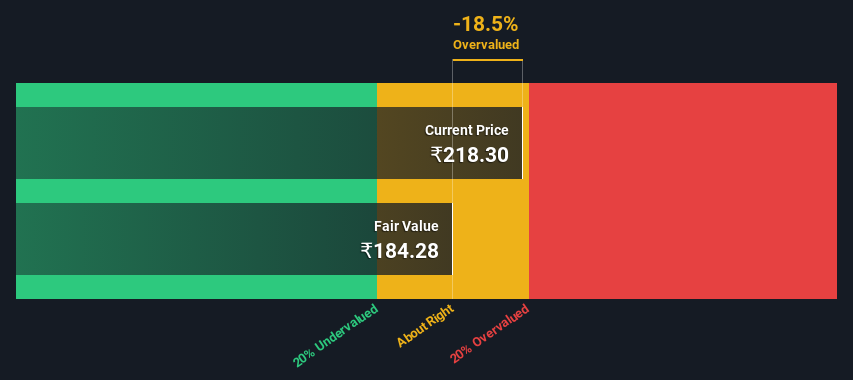Estimating The Fair Value Of Sati Poly Plast Limited (NSE:SATIPOLY)

Key Insights
- The projected fair value for Sati Poly Plast is ₹184 based on 2 Stage Free Cash Flow to Equity
- With ₹218 share price, Sati Poly Plast appears to be trading close to its estimated fair value
- Industry average of 1,919% suggests Sati Poly Plast's peers are currently trading at a higher premium to fair value
In this article we are going to estimate the intrinsic value of Sati Poly Plast Limited (NSE:SATIPOLY) by taking the forecast future cash flows of the company and discounting them back to today's value. Our analysis will employ the Discounted Cash Flow (DCF) model. Models like these may appear beyond the comprehension of a lay person, but they're fairly easy to follow.
We generally believe that a company's value is the present value of all of the cash it will generate in the future. However, a DCF is just one valuation metric among many, and it is not without flaws. For those who are keen learners of equity analysis, the Simply Wall St analysis model here may be something of interest to you.
View our latest analysis for Sati Poly Plast
The Model
We use what is known as a 2-stage model, which simply means we have two different periods of growth rates for the company's cash flows. Generally the first stage is higher growth, and the second stage is a lower growth phase. To start off with, we need to estimate the next ten years of cash flows. Seeing as no analyst estimates of free cash flow are available to us, we have extrapolate the previous free cash flow (FCF) from the company's last reported value. We assume companies with shrinking free cash flow will slow their rate of shrinkage, and that companies with growing free cash flow will see their growth rate slow, over this period. We do this to reflect that growth tends to slow more in the early years than it does in later years.
Generally we assume that a dollar today is more valuable than a dollar in the future, so we discount the value of these future cash flows to their estimated value in today's dollars:
10-year free cash flow (FCF) forecast
| 2025 | 2026 | 2027 | 2028 | 2029 | 2030 | 2031 | 2032 | 2033 | 2034 | |
| Levered FCF (₹, Millions) | ₹48.2m | ₹52.8m | ₹57.4m | ₹62.0m | ₹66.8m | ₹71.7m | ₹76.9m | ₹82.3m | ₹88.0m | ₹94.0m |
| Growth Rate Estimate Source | Est @ 10.71% | Est @ 9.51% | Est @ 8.67% | Est @ 8.08% | Est @ 7.66% | Est @ 7.37% | Est @ 7.17% | Est @ 7.03% | Est @ 6.93% | Est @ 6.86% |
| Present Value (₹, Millions) Discounted @ 12% | ₹42.9 | ₹41.8 | ₹40.4 | ₹38.9 | ₹37.3 | ₹35.6 | ₹33.9 | ₹32.3 | ₹30.8 | ₹29.2 |
("Est" = FCF growth rate estimated by Simply Wall St)
Present Value of 10-year Cash Flow (PVCF) = ₹363m
After calculating the present value of future cash flows in the initial 10-year period, we need to calculate the Terminal Value, which accounts for all future cash flows beyond the first stage. The Gordon Growth formula is used to calculate Terminal Value at a future annual growth rate equal to the 5-year average of the 10-year government bond yield of 6.7%. We discount the terminal cash flows to today's value at a cost of equity of 12%.
Terminal Value (TV)= FCF2034 × (1 + g) ÷ (r – g) = ₹94m× (1 + 6.7%) ÷ (12%– 6.7%) = ₹1.8b
Present Value of Terminal Value (PVTV)= TV / (1 + r)10= ₹1.8b÷ ( 1 + 12%)10= ₹548m
The total value, or equity value, is then the sum of the present value of the future cash flows, which in this case is ₹912m. To get the intrinsic value per share, we divide this by the total number of shares outstanding. Relative to the current share price of ₹218, the company appears around fair value at the time of writing. Remember though, that this is just an approximate valuation, and like any complex formula - garbage in, garbage out.

Important Assumptions
The calculation above is very dependent on two assumptions. The first is the discount rate and the other is the cash flows. If you don't agree with these result, have a go at the calculation yourself and play with the assumptions. The DCF also does not consider the possible cyclicality of an industry, or a company's future capital requirements, so it does not give a full picture of a company's potential performance. Given that we are looking at Sati Poly Plast as potential shareholders, the cost of equity is used as the discount rate, rather than the cost of capital (or weighted average cost of capital, WACC) which accounts for debt. In this calculation we've used 12%, which is based on a levered beta of 0.837. Beta is a measure of a stock's volatility, compared to the market as a whole. We get our beta from the industry average beta of globally comparable companies, with an imposed limit between 0.8 and 2.0, which is a reasonable range for a stable business.
Moving On:
Valuation is only one side of the coin in terms of building your investment thesis, and it is only one of many factors that you need to assess for a company. The DCF model is not a perfect stock valuation tool. Rather it should be seen as a guide to "what assumptions need to be true for this stock to be under/overvalued?" For instance, if the terminal value growth rate is adjusted slightly, it can dramatically alter the overall result. For Sati Poly Plast, we've put together three additional elements you should look at:
- Risks: For instance, we've identified 3 warning signs for Sati Poly Plast that you should be aware of.
- Other Solid Businesses: Low debt, high returns on equity and good past performance are fundamental to a strong business. Why not explore our interactive list of stocks with solid business fundamentals to see if there are other companies you may not have considered!
- Other Top Analyst Picks: Interested to see what the analysts are thinking? Take a look at our interactive list of analysts' top stock picks to find out what they feel might have an attractive future outlook!
PS. The Simply Wall St app conducts a discounted cash flow valuation for every stock on the NSEI every day. If you want to find the calculation for other stocks just search here.
New: Manage All Your Stock Portfolios in One Place
We've created the ultimate portfolio companion for stock investors, and it's free.
• Connect an unlimited number of Portfolios and see your total in one currency
• Be alerted to new Warning Signs or Risks via email or mobile
• Track the Fair Value of your stocks
Have feedback on this article? Concerned about the content? Get in touch with us directly. Alternatively, email editorial-team (at) simplywallst.com.
This article by Simply Wall St is general in nature. We provide commentary based on historical data and analyst forecasts only using an unbiased methodology and our articles are not intended to be financial advice. It does not constitute a recommendation to buy or sell any stock, and does not take account of your objectives, or your financial situation. We aim to bring you long-term focused analysis driven by fundamental data. Note that our analysis may not factor in the latest price-sensitive company announcements or qualitative material. Simply Wall St has no position in any stocks mentioned.
About NSEI:SATIPOLY
Sati Poly Plast
Engages in the manufacturing and sale of flexible packaging materials for the packaging requirements of various industries in India and internationally.
Solid track record with excellent balance sheet.
Similar Companies
Market Insights
Community Narratives



